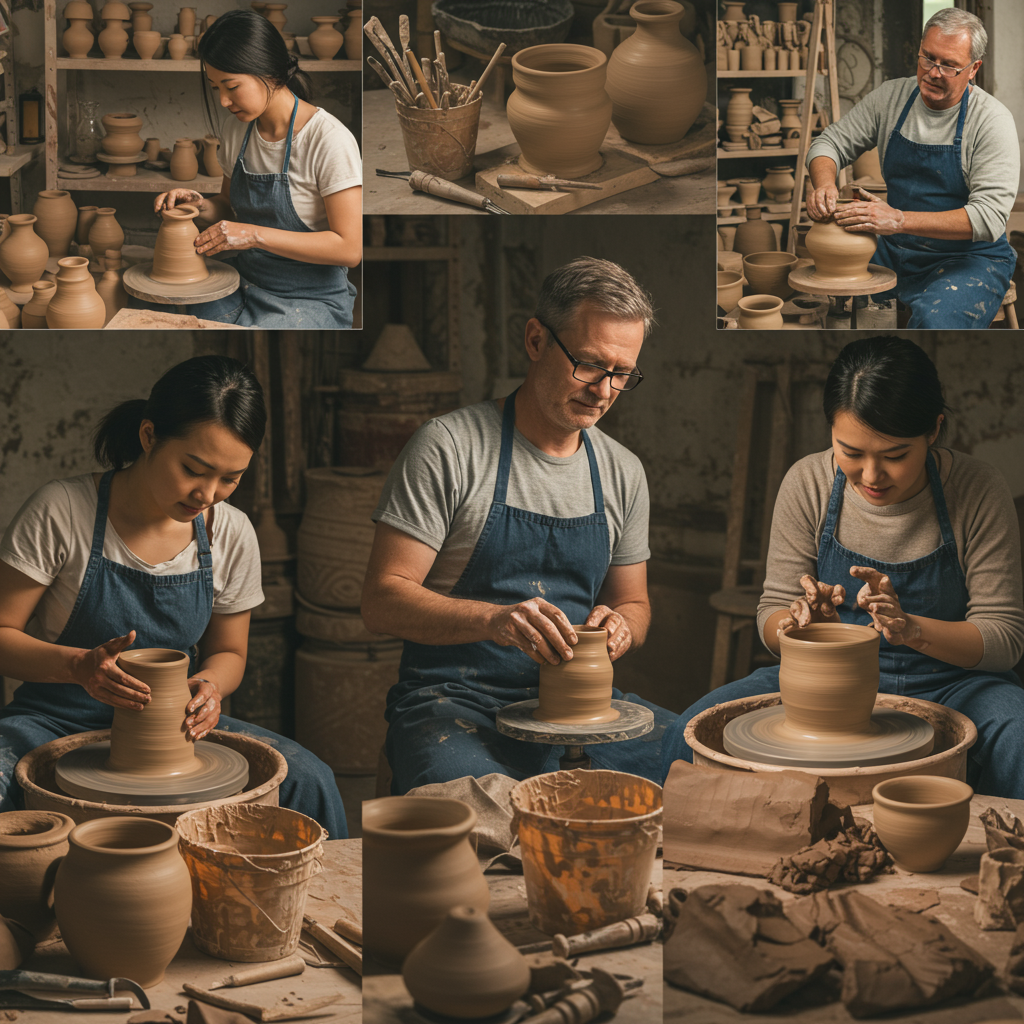From the moment human hands first pressed into damp earth, discovering its malleable nature, the story of pottery and ceramics began. It’s a narrative deeply interwoven with our own development, tracing a path from basic survival needs to sophisticated artistic expression. Clay, that humble mixture of minerals and water, holds within it the potential for transformation – a potential unlocked by the controlled application of fire. This alchemy, turning soft mud into durable, useful, and often beautiful objects, marks one of humanity’s earliest and most enduring technological and artistic achievements.
The Dawn of Fired Earth
The earliest ceramic objects weren’t necessarily pots. Figurines, like the Venus of Dolní Věstonice found in the Czech Republic, date back tens of thousands of years, suggesting early experiments with firing clay long before the need for storage vessels became paramount. However, the widespread development of pottery is strongly linked to the Neolithic Revolution, around 10,000 BCE. As humans transitioned from nomadic hunter-gatherer lifestyles to settled agricultural communities, the need arose for containers to store grain, water, and food. Early pottery was hand-built, using techniques still practiced today.
Simple pinch pots were formed by squeezing a lump of clay. Larger vessels were often created using the
coiling method, where long ropes of clay were layered atop one another and then smoothed. Slab building, using flattened pieces of clay joined together, was another fundamental technique. These early pots were typically fired in open bonfires or rudimentary pit kilns. The temperatures achieved were relatively low, resulting in porous earthenware, often dark in color due to the firing conditions. Decoration was initially simple – impressions made with fingers, tools, or natural objects like shells and cords pressed into the wet clay before firing.
Archaeological evidence confirms the existence of fired clay objects dating back as far as 29,000 BCE. However, the systematic production of ceramic vessels for storage and cooking became widespread with the advent of agriculture during the Neolithic period. These early pots provide invaluable insights into the daily lives and technological capabilities of ancient societies.
The Wheel Turns: A Revolution in Clay
A monumental leap forward occurred with the invention of the potter’s wheel, believed to have originated in Mesopotamia around the 4th millennium BCE. Initially, it may have been a slow-moving platform (a tournette) used to aid in hand-building or decorating. However, the development of the fast kick-wheel revolutionized pottery production. This tool allowed potters to ‘throw’ pots, using centrifugal force to shape the clay quickly and efficiently into symmetrical forms. The wheel enabled greater standardization, increased production speed, and opened up new possibilities for creating thinner-walled, more refined shapes. This technological advance coincided with the rise of complex societies and urban centers, where demand for pottery grew significantly.
Ceramics in Ancient Empires
Different civilizations harnessed the potential of clay in unique ways, reflecting their distinct cultures, resources, and technological prowess.
Mesopotamia and Egypt
In the fertile crescent of Mesopotamia, clay was abundant. Sun-dried and kiln-fired bricks formed the basis of monumental architecture like ziggurats. Potters produced a range of utilitarian wares, and early forms of glaze were developed, initially alkaline glazes producing bluish-green colors. Neighbouring Egypt also utilized pottery extensively for daily life and funerary practices. They are particularly noted for
Egyptian faience, not a true clay-based ceramic but a quartz-based material coated with an alkaline glaze that fired to bright blue and green hues. This was used for beads, tiles, and small decorative objects.
Aegean and Greek Mastery
The Minoan and Mycenaean civilizations of the Aegean produced vibrant pottery, but it was in ancient Greece that ceramic art reached an early zenith. Greek potters mastered the wheel, creating iconic and balanced forms like the
amphora (for storage and transport), the
kylix (a drinking cup), and the
krater (for mixing wine and water). Beyond form, Greek pottery is famed for its intricate narrative decoration. Early geometric patterns gave way to the sophisticated black-figure technique (black figures on a red background) and later the red-figure technique (red figures on a black background, allowing for more detailed rendering). These painted vases depicted myths, legends, and scenes of daily life, serving not only practical purposes but also as significant mediums for storytelling and artistic expression. They were widely traded throughout the Mediterranean, spreading Greek culture and artistic influence.
Roman Pragmatism
The Roman Empire, known for its engineering and organizational skills, approached ceramics with characteristic pragmatism. While influenced by Greek forms, Roman pottery often emphasized functionality and mass production. A key Roman ceramic type was
Terra Sigillata, a glossy red earthenware produced in large quantities in specialized workshops, particularly in Gaul and Italy. Standardized forms, relief decoration using molds, and maker’s stamps were common. Roman pottery, including bricks, tiles, pipes, and vessels, spread throughout the vast empire, demonstrating their industrial capacity and the importance of ceramics in Roman infrastructure and daily life.
Eastern Innovations: Stoneware and Porcelain
While Europe primarily worked with earthenware, unparalleled advancements were taking place in East Asia, particularly in China.
China: The Ceramic Superpower
China’s history with ceramics is exceptionally long and innovative. As early as the Shang and Zhou dynasties (c. 1600–256 BCE), Chinese potters were developing high-temperature kilns capable of producing
stoneware – a harder, less porous ceramic fired at temperatures where the clay body begins to vitrify. This laid the groundwork for the ultimate ceramic achievement: porcelain. Perfected during the Tang (618–907 CE) and Song (960–1279 CE) dynasties, true porcelain is made from specific materials (kaolin clay and petuntse stone) fired at very high temperatures (around 1200–1400°C). The result is a translucent, white, strong, and resonant ceramic body.
Alongside the development of porcelain, China excelled in glaze technology. Famous examples include the subtle green
celadon glazes of the Song dynasty, prized for their jade-like appearance, and the vibrant lead-based sancai (‘three-color’) glazes of the Tang dynasty. Later, during the Yuan and Ming dynasties, underglaze blue decoration using cobalt oxide on white porcelain – the famous
Blue and White ware – became immensely popular both domestically and as a major export commodity, profoundly influencing ceramic traditions worldwide.
Korea and Japan
Neighboring Korea developed its own esteemed ceramic traditions, heavily influenced by China but with distinct characteristics. Korean potters were particularly renowned for their celadon glazes during the Goryeo dynasty (918–1392), often considered to surpass even Chinese examples in their subtlety and beauty, sometimes featuring inlaid decoration (sanggam). Japan also absorbed influences from China and Korea, initially importing and imitating wares. Over time, however, Japan developed profoundly unique ceramic aesthetics, closely tied to philosophical and cultural movements like Zen Buddhism and the tea ceremony (Chanoyu). Wares like the rustic, hand-built Raku, the unglazed, high-fired Bizen and Shigaraki, and the feldspathic glazed Shino embody Japanese ideals of naturalness, imperfection (wabi-sabi), and appreciation for the materials and processes themselves.
Islamic Glazes and Tiles
Following the rise of Islam in the 7th century CE, artisans across the Middle East, North Africa, and Spain built upon existing ceramic traditions, particularly those of the Sasanian Empire. While religious reservations sometimes discouraged figurative representation, Islamic potters excelled in developing intricate geometric patterns, floral motifs (arabesques), and calligraphy as decoration. A major contribution was the mastery and spread of
tin-glazing. Adding tin oxide to a lead glaze created an opaque white surface, providing an excellent ground for painted decoration, mimicking expensive Chinese porcelain. Perhaps the most dazzling Islamic contribution was the development of
lusterware, a technique involving metallic pigments applied over a fired glaze and then fired again in a reducing atmosphere to create shimmering, iridescent effects.
Ceramics also played a vital role in Islamic architecture, with brilliantly colored glazed tiles adorning mosques, palaces, and public buildings. Iznik pottery from Ottoman Turkey, known for its high-quality quartz-frit body and vibrant floral designs in blue, turquoise, green, and red under a clear glaze, represents a high point of Islamic tilework and ceramic vessel production.
Europe: Catching Up and Innovating
During the Middle Ages, European pottery remained relatively simple, primarily functional earthenware. The arrival of sophisticated Islamic ceramics via Spain (Hispano-Moresque ware) and Italian trade with the East began to inspire change. During the Renaissance, Italian potters developed
Maiolica, a vibrant form of tin-glazed earthenware featuring narrative and decorative painting. This technique spread, leading to Delftware in the Netherlands (often blue and white, imitating Chinese porcelain), Faience in France, and English Delftware.
The ultimate goal for European potters, however, was to replicate true Chinese porcelain. For centuries, its composition remained a mystery. Intense experimentation finally led to success in the early 18th century at Meissen, Germany, under the patronage of Augustus the Strong. Johann Friedrich Böttger is credited with producing the first European hard-paste porcelain around 1708. Soon, other centers like Sèvres in France and factories across Europe began producing their own porcelain, initially imitating Asian styles but quickly developing distinct European aesthetics, often characterized by Rococo and Neoclassical influences.
Industrialization and the Studio Movement
The Industrial Revolution in the 18th and 19th centuries brought significant changes to ceramic production. Figures like Josiah Wedgwood in England pioneered factory production methods, introducing division of labor, new technologies like transfer printing for decoration, and improved clay bodies like creamware and Jasperware. This led to greater availability and affordability of ceramics but also began to distance the maker from the craft. Utilitarian wares became increasingly standardized.
As a reaction against industrial mass production, the late 19th and early 20th centuries saw the rise of the Arts and Crafts movement and later the
Studio Pottery movement. Led by influential figures like Bernard Leach (UK) and Shoji Hamada (Japan), this movement emphasized the value of handmade objects, the skill of the individual potter, and drew inspiration from historical and non-Western ceramic traditions, particularly those of East Asia. This revitalized ceramics as an art form, distinct from industrial production, focusing on individual expression, form, glaze, and the firing process itself.
Contemporary Ceramics
Today, the world of ceramics is incredibly diverse. It encompasses everything from large-scale industrial production of tiles, sanitaryware, and tableware to individual artists pushing the boundaries of the medium. Studio potters continue to create functional ware with an emphasis on craftsmanship and aesthetics. Ceramic artists, however, often use clay primarily as a sculptural medium, exploring conceptual ideas, experimenting with unconventional techniques, and incorporating ceramics into mixed-media installations. Technology continues to play a role, with advancements in digital design, 3D printing in clay, and new glaze and firing possibilities. Yet, the fundamental connection to the earth, the transformation through fire, and the balance between utility and beauty remain central to this enduring human craft.
From the earliest functional vessels shaped by necessity to the complex sculptures and refined porcelain of today, ceramics chart a course through human history. They are artifacts of daily life, markers of technological progress, mediums for artistic expression, and symbols of cultural identity. The simple act of shaping clay and hardening it with fire continues to connect us to our ancestors and offers endless possibilities for future creativity.








